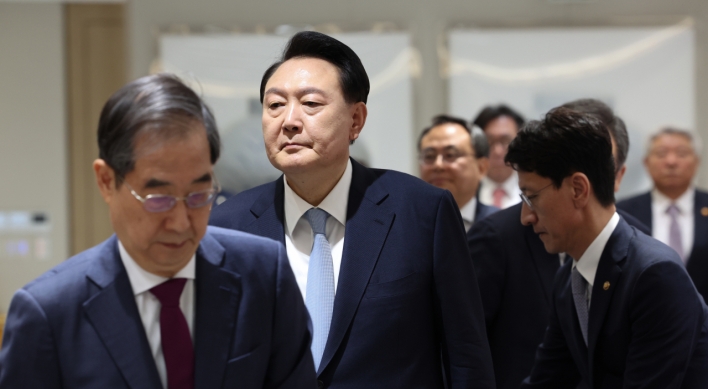[Editorial] Brace for a protracted fight
Virus getting out of control; tougher steps, concerted response needed
By Korea HeraldPublished : Feb. 23, 2020 - 17:07
The spread of COVID-19 is increasing sharply, with the bulk of new cases concentrated in Daegu and nearby North Gyeongsang Province.
The number of confirmed cases in South Korea rose to 602 on Sunday, since the nation’s first case was reported Jan. 20. It was a whopping increase within just a few days, and five patients have already died.
The new coronavirus that causes the disease has spread nationwide, with all eight metropolitan cities and nine provinces reporting confirmed cases.
The rapid increase in the number of COVID-19 patients has stretched the capacity of the nation’s epidemiological investigators, who number about 140, fueling fear that the situation may be turning into a pandemic.
The response of President Moon Jae-in and his administration since the first case emerged is disappointing. They seem complacent, even as the situation worsens.
Moon instructed Prime Minister Chung Sye-kyun on Friday to find and inspect all those who attended services, including a funeral, linked to the Shincheonji Church of Jesus, Temple of the Tabernacle of the Testimony -- the religious group at the center of the massive COVID-19 outbreak in Daegu and North Gyeongsang Province.
Of course, it is necessary to track the churchgoers who attended the events, but it seems like a lukewarm instruction from the president when transmission of the virus is accelerating throughout the country.
Daegu can’t handle the abrupt surge of cases on its own. Its mayor said that “the city is short of medical personnel and materials.”
There are 1,027 negative-pressure isolation wards throughout the country, but only 54 in Daegu -- where the number of confirmed cases topped 200 just four days after the first one was reported on Feb. 18.
Experts warned early on that it would be hard to control the spread of the virus in the community and called on the government to take proactive measures, including a temporary entry ban on visitors from all parts of China. But the government turned a deaf ear.
Though the number of patients soared, the government initially maintained an alert level of “vigilance.” Only on Sunday afternoon did Moon finally raise it to the highest level, “serious.” There was no mention of any additional restrictions on people entering the country from China.
At first, the government vowed to respond proactively, to err on the side of caution, but now it is questionable whether it has walked the talk.
Health and Welfare Minister Park Neung-hoo said that “there are cases of infections from Chinese tourists, but Koreans who visited China caused more infections here.”
His remarks give the impression that Koreans are more to blame than Chinese travelers.
Most of the recent cases are linked to the activities of a secretive religious sect, but the church is not the source of the virus.
Korea might not be facing this situation if it had cut off the source of infection at the start, as experts recommended and many people demanded.
Now Korea has the largest number of confirmed cases apart from China and the cruise ship moored at a Japanese port.
No one in the government has explained formally why it did not stop the inflow of travelers from China from the beginning. Now the government has pointed the finger at Koreans, as if they were more problematic than Chinese. This is disappointing. The first Shincheonji follower to be infected -- Korea’s 31st confirmed patient -- caught the virus via an unknown route.
Though belatedly, Korea must consider strengthening restrictions on entry into the country from all of China for the time being. Soon, about 70,000 Chinese students will come back here to begin a new semester.
Community spread has already begun. The government must shift the focus to minimizing damage, while trying to stem the inflow of people who might be sources of infection.
Hopes of an early end to the crisis have all but vanished. COVID-19 is spreading out of control, and the country is in for a full-scale and long-term fight.
If the number of patients keeps increasing, the authorities will be required to use medical resources more efficiently. Inefficient utilization of resources is a shortcut to defeat in the fight against a contagious disease.
The first test is to extinguish the massive outbreak in Daegu and North Gyeongsang Province. If the government fails, it will become much more difficult to stop the disease from running rampant.
Not only the government, but citizens too, must do their part faithfully. They ought to take preventive measures, such as maintaining personal hygiene, and undergo virus screening.
Now is the time for the entire nation to make a concerted effort to overcome the crisis.
The number of confirmed cases in South Korea rose to 602 on Sunday, since the nation’s first case was reported Jan. 20. It was a whopping increase within just a few days, and five patients have already died.
The new coronavirus that causes the disease has spread nationwide, with all eight metropolitan cities and nine provinces reporting confirmed cases.
The rapid increase in the number of COVID-19 patients has stretched the capacity of the nation’s epidemiological investigators, who number about 140, fueling fear that the situation may be turning into a pandemic.
The response of President Moon Jae-in and his administration since the first case emerged is disappointing. They seem complacent, even as the situation worsens.
Moon instructed Prime Minister Chung Sye-kyun on Friday to find and inspect all those who attended services, including a funeral, linked to the Shincheonji Church of Jesus, Temple of the Tabernacle of the Testimony -- the religious group at the center of the massive COVID-19 outbreak in Daegu and North Gyeongsang Province.
Of course, it is necessary to track the churchgoers who attended the events, but it seems like a lukewarm instruction from the president when transmission of the virus is accelerating throughout the country.
Daegu can’t handle the abrupt surge of cases on its own. Its mayor said that “the city is short of medical personnel and materials.”
There are 1,027 negative-pressure isolation wards throughout the country, but only 54 in Daegu -- where the number of confirmed cases topped 200 just four days after the first one was reported on Feb. 18.
Experts warned early on that it would be hard to control the spread of the virus in the community and called on the government to take proactive measures, including a temporary entry ban on visitors from all parts of China. But the government turned a deaf ear.
Though the number of patients soared, the government initially maintained an alert level of “vigilance.” Only on Sunday afternoon did Moon finally raise it to the highest level, “serious.” There was no mention of any additional restrictions on people entering the country from China.
At first, the government vowed to respond proactively, to err on the side of caution, but now it is questionable whether it has walked the talk.
Health and Welfare Minister Park Neung-hoo said that “there are cases of infections from Chinese tourists, but Koreans who visited China caused more infections here.”
His remarks give the impression that Koreans are more to blame than Chinese travelers.
Most of the recent cases are linked to the activities of a secretive religious sect, but the church is not the source of the virus.
Korea might not be facing this situation if it had cut off the source of infection at the start, as experts recommended and many people demanded.
Now Korea has the largest number of confirmed cases apart from China and the cruise ship moored at a Japanese port.
No one in the government has explained formally why it did not stop the inflow of travelers from China from the beginning. Now the government has pointed the finger at Koreans, as if they were more problematic than Chinese. This is disappointing. The first Shincheonji follower to be infected -- Korea’s 31st confirmed patient -- caught the virus via an unknown route.
Though belatedly, Korea must consider strengthening restrictions on entry into the country from all of China for the time being. Soon, about 70,000 Chinese students will come back here to begin a new semester.
Community spread has already begun. The government must shift the focus to minimizing damage, while trying to stem the inflow of people who might be sources of infection.
Hopes of an early end to the crisis have all but vanished. COVID-19 is spreading out of control, and the country is in for a full-scale and long-term fight.
If the number of patients keeps increasing, the authorities will be required to use medical resources more efficiently. Inefficient utilization of resources is a shortcut to defeat in the fight against a contagious disease.
The first test is to extinguish the massive outbreak in Daegu and North Gyeongsang Province. If the government fails, it will become much more difficult to stop the disease from running rampant.
Not only the government, but citizens too, must do their part faithfully. They ought to take preventive measures, such as maintaining personal hygiene, and undergo virus screening.
Now is the time for the entire nation to make a concerted effort to overcome the crisis.
-
Articles by Korea Herald








![[KH Explains] How should Korea adjust its trade defenses against Chinese EVs?](http://res.heraldm.com/phpwas/restmb_idxmake.php?idx=644&simg=/content/image/2024/04/15/20240415050562_0.jpg&u=20240415144419)











